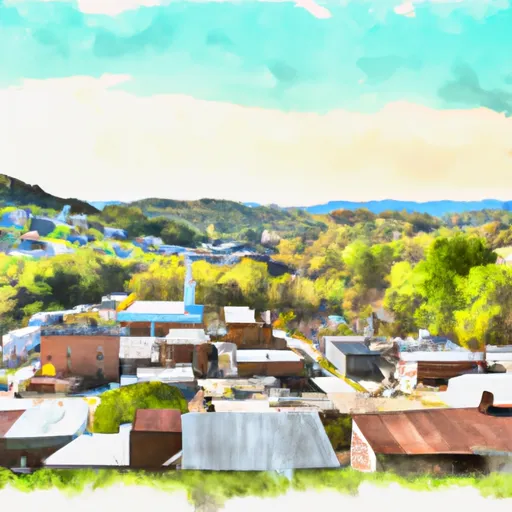-
 Snoflo Premium
Snoflo Premium
Get unlimited access to all our content
With no Ad interruptions! - Start Your Free Trial Login with existing account
Mount-Herman
Eden Index
Climate
7.8
•
Recreation
1.1
•
Community
•
Safeguard
3.5/10

Mount Herman is a small town nestled in the beautiful state of Kentucky. The climate in this region is considered humid subtropical, experiencing warm summers and mild winters. It receives a moderate amount of rainfall, making it an ideal place for various outdoor activities.
Situated near the Green River, Mount Herman benefits from abundant hydrological resources. The river system supports various aquatic life and is a haven for fishing enthusiasts. Moreover, the region features several creeks and streams that contribute to the stunning natural beauty of the area.
Outdoor recreation opportunities abound in Mount Herman. The town is surrounded by vast stretches of forests, perfect for hiking, camping, and birdwatching. The scenic landscapes are also ideal for photography and nature enthusiasts. The nearby Green River provides opportunities for boating, kayaking, and canoeing.
In conclusion, Mount Herman, Kentucky offers a pleasant climate, abundant hydrology constituents, and ample outdoor recreation opportunities. Whether you enjoy fishing, hiking, or simply immersing yourself in nature, this charming town has it all.
What is the Eden Index?
The Snoflo Eden Index serves as a comprehensive rating system for regions, evaluating their desirability through a holistic assessment of climate health, outdoor recreation opportunities, and natural disaster risk, acknowledging the profound impact of these factors on livability and well-being.
Climate Health Indicator (CHI): 7.8
Mount-Herman receives approximately
1317mm of rain per year,
with humidity levels near 87%
and air temperatures averaging around
14°C.
Mount-Herman has a plant hardyness factor of
6, meaning
plants and agriculture in this region thrive during a short period during spring and early summer. Most
plants will die off during the colder winter months.
By considering the ideal temperature range, reliable water supplies, clean air, and stable seasonal rain or snowpacks, the Climate Health Indicator (CHI) underscores the significance of a healthy climate as the foundation for quality living.
A healthy climate is paramount for ensuring a high quality of life and livability in a region, fostering both physical well-being and environmental harmony. This can be characterized by ideal temperatures, reliable access to water supplies, clean air, and consistent seasonal rain or snowpacks.
Weather Forecast
Streamflow Conditions
Green
Area Rivers
Green
Snowpack Depths
Green
Reservoir Storage Capacity
Green
Groundwater Levels
Recreational Opportunity Index (ROI): 1.1
The Recreational Opportunity Index (ROI) recognizes the value of outdoor recreational options, such as parks, hiking trails, camping sites, and fishing spots, while acknowledging that climate plays a pivotal role in ensuring the comfort and consistency of these experiences.
Access to outdoor recreational opportunities, encompassing activities such as parks, hiking, camping, and fishing, is crucial for overall well-being, and the climate plays a pivotal role in enabling and enhancing these experiences, ensuring that individuals can engage in nature-based activities comfortably and consistently.
Camping Areas
| Campground | Campsites | Reservations | Toilets | Showers | Elevation |
|---|---|---|---|---|---|
| Jackson County Park | None | 627 ft | |||
| Stevenson Municipal Park - Guntersville Reservoir | None | 599 ft | |||
| Holmes Creek - Center Hill Lake | None | 749 ft | |||
| Noccalula Falls Campground | None | 732 ft | |||
| Dekalb County Public Lake | None | 1,317 ft | |||
| De Soto State Park | 94 | 1,477 ft | |||
| Long Branch - Center Hill Lake | 60 | 818 ft | |||
| Floating Mill - Center Hill Lake | None | 977 ft | |||
| Foster Falls | 26 | 1,780 ft | |||
| Shellmound - Nickajack Dam Reservation | None | 678 ft |
Nearby Ski Areas
Catastrophe Safeguard Index (CSI):
The Catastrophe Safeguard Index (CSI) recognizes that natural disaster risk, encompassing floods, fires, hurricanes, and tornadoes, can drastically affect safety and the overall appeal of an area.
The level of natural disaster risk in a region significantly affects safety and the overall livability, with climate change amplifying these risks by potentially increasing the frequency and intensity of events like floods, fires, hurricanes, and tornadoes, thereby posing substantial challenges to community resilience and well-being.
Community Resilience Indicator (CRI):
The Community Resilience Indicator (CRI) recognizes that education, healthcare, and socioeconomics are crucial to the well-being of a region. The CRI acknowledges the profound impact of these elements on residents' overall quality of life. By evaluating educational resources, healthcare accessibility, and economic inclusivity, the index captures the essential aspects that contribute to a thriving community, fostering resident satisfaction, equity, and social cohesion.

